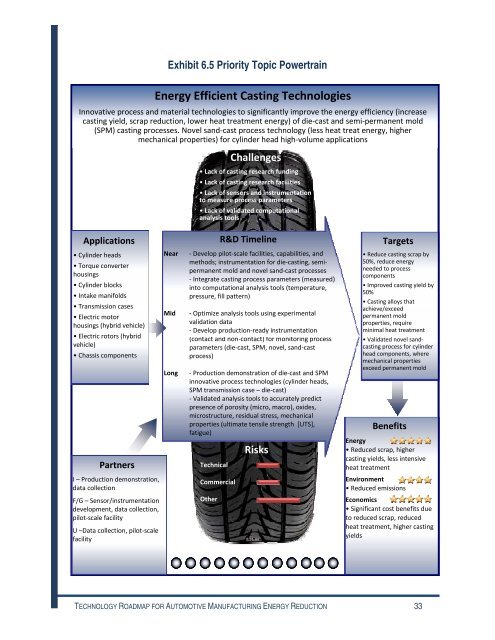Technology Roadmap for Energy Reduction in Automotive
Technology Roadmap for Energy Reduction in Automotive
Technology Roadmap for Energy Reduction in Automotive
Create successful ePaper yourself
Turn your PDF publications into a flip-book with our unique Google optimized e-Paper software.
Applications<br />
•Cyl<strong>in</strong>der heads<br />
•Torque converter<br />
hous<strong>in</strong>gs<br />
•Cyl<strong>in</strong>der blocks<br />
•Intake manifolds<br />
•Transmission cases<br />
•Electric motor<br />
hous<strong>in</strong>gs (hybrid vehicle)<br />
•Electric rotors (hybrid<br />
vehicle)<br />
•Chassis components<br />
Exhibit 6.5 Priority Topic Powertra<strong>in</strong><br />
<strong>Energy</strong> Efficient Cast<strong>in</strong>g Technologies<br />
Innovative process and material technologies to significantly improve the energy efficiency (<strong>in</strong>crease<br />
cast<strong>in</strong>g yield, scrap reduction, lower heat treatment energy) of die‐cast die‐ cast and semi‐permanent semi‐ permanent mold<br />
(SPM) cast<strong>in</strong>g processes. Novel sand‐cast sand‐ cast process technology (less heat treat energy, higher<br />
mechanical properties) <strong>for</strong> cyl<strong>in</strong>der head high‐volume high‐ volume applications<br />
Partners<br />
I –Productiondemonstration,<br />
–Production demonstration,<br />
data collection<br />
F/G – Sensor/<strong>in</strong>strumentation<br />
development, data collection,<br />
pilot‐scale facility<br />
U –Data collection, pilot‐scale<br />
facility<br />
• Lack of cast<strong>in</strong>g research fund<strong>in</strong>g<br />
• Lack of cast<strong>in</strong>g research facilities<br />
• Lack of sensors and <strong>in</strong>strumentation<br />
to measure process parameters<br />
• Lack of validated computational<br />
analysis tools<br />
R&D Timel<strong>in</strong>e<br />
Near ‐ Develop pilot pilot‐scale ‐ scale facilities, capabilities, and<br />
methods; met hods; <strong>in</strong>strumentation <strong>for</strong> die die‐cast<strong>in</strong>g, ‐ cast<strong>in</strong>g, se semi‐ mi‐<br />
permanent mold and novel sand sand‐cast ‐ cast proces processes ses<br />
‐ ‐ Integrate cast<strong>in</strong>g process parameters (mea (measured) sured)<br />
<strong>in</strong>to com computational putational analysis tools (temperatu (temperature, re,<br />
pre pressure, ssure,<br />
fill pattern)<br />
Mid ‐ Optimize analysis tools us<strong>in</strong>g experimental<br />
validation data<br />
‐ Develop production‐ready <strong>in</strong>strumentation<br />
(conta (contact ct and non non‐contact) ‐ contact) <strong>for</strong> monitor<strong>in</strong>g pr process ocess<br />
parameters parameters (die (die‐cast, ‐ cast, SPM, novel, sand sand‐cast ‐ cast<br />
process)<br />
Long ‐ Production demonstration of die die‐cast ‐ cast and SPM<br />
<strong>in</strong>novative process technologies (cyl<strong>in</strong>der he heads, ads,<br />
SPM transmission case –diecast) –die‐cast) ‐<br />
‐ Validated analysis tools to accurately predic predict t<br />
prese presence nce of porosity (micro, macro), oxides,<br />
mmicrostructure,<br />
icrostructure, residual stress, mechanical<br />
pproperties<br />
roperties (ultimate tensile strength [UTS],<br />
ffatigue)<br />
atigue)<br />
Technical<br />
Commercial<br />
Other<br />
Challenges<br />
Risks<br />
8.31.09<br />
Targets<br />
• Reduce cast<strong>in</strong>g scrap by<br />
50%, reduce energy<br />
needed to process<br />
components<br />
•Improvedcast<strong>in</strong>g •Improved cast<strong>in</strong>g yield by<br />
50%<br />
•Cast<strong>in</strong>galloys •Cast<strong>in</strong>g alloys that<br />
achieve/exceed<br />
permanent mold<br />
properties, require<br />
m<strong>in</strong>imal heat treatment<br />
• Validated novel sand‐<br />
cast<strong>in</strong>g process <strong>for</strong> cyl<strong>in</strong>der<br />
head components, where<br />
mechanical properties<br />
exceed permanent mold<br />
Benefits<br />
<strong>Energy</strong><br />
•Reducedscrap, •Reduced scrap, higher<br />
cast<strong>in</strong>g yields, less <strong>in</strong>tensive<br />
heat treatment<br />
Environment<br />
•Reducedemissions<br />
•Reduced emissions<br />
Economics<br />
• Significant cost benefits due<br />
to reduced scrap, reduced<br />
heat treatment, higher cast<strong>in</strong>g<br />
yields<br />
TECHNOLOGY ROADMAP FOR AUTOMOTIVE MANUFACTURING ENERGY REDUCTION 33

















